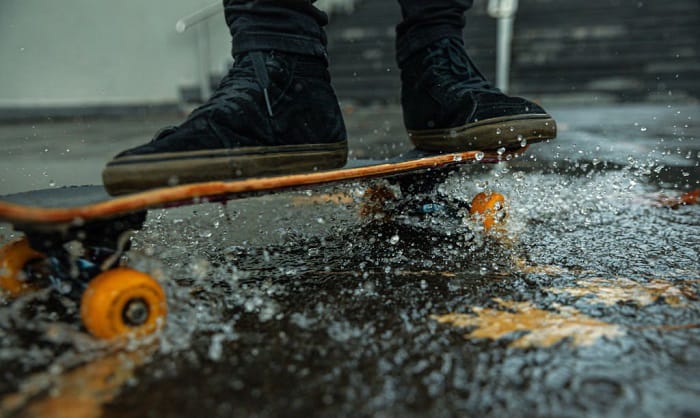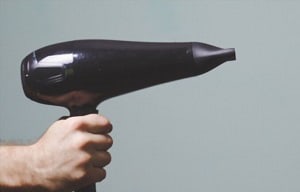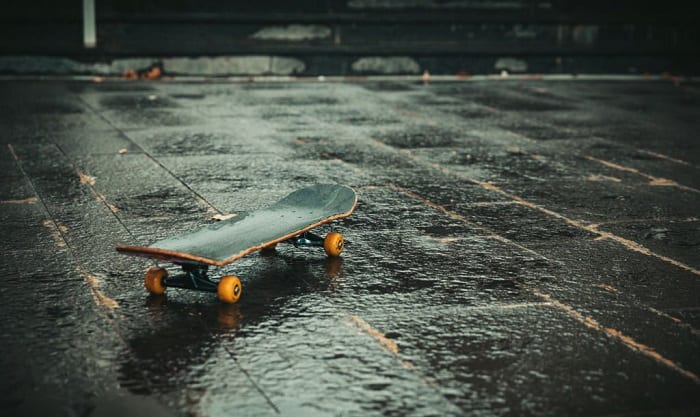Sunny days are almost always a sports enthusiast’s wish. As they say, you can do anything under the sun. True enough, skateboarding thrives well under sunlit or dry weather. Riding in wet weather entails risks for you and the skateboard.
One of these hazards is coming home with a wet skateboard. But that does not mean you’ll have to throw the board away immediately after getting it soaked.
Let me teach you how to fix a waterlogged skateboard to make it functional when it is dry.
Table of Contents
What to Do if Your Skateboard Gets Wet
Deciding whether to revive a wet skateboard or never reuse it remains a question for many. But after knowing the following things, you’ll probably have the confidence to restore a skateboard in water.
Prepare the following
- Skate tool – A T-tool isn’t only for assembling skateboards but also for dismantling them. We’ll need a skate tool to detach some parts of the wet deck.
- A towel – Use a towel to help remove any form of liquid on the skateboard’s surface.
- A drying device – The sun may still not be our friend the moment we decide to save the skateboard right after getting it wet. So, we need a fan or a hair dryer to hasten the drying process.
- Wood filler – Part of the wooden body of the skateboard may already show signs of wearing out, but applying some wood filler may restore it to its solid form.
- Putty knife
- Sandpaper
- Bearings – Wet skateboards more often mean wet bearings. Thus, it may be best to replace waterlogged bearings for better performance.
Ways to Fix a Waterlogged Skateboard
Fixing a waterlogged skateboard call for a simple solution, drying it out and solidifying it. Take note of these steps.
1. Wiping exterior liquid
Some skateboarders are lucky enough to have their skateboards wet near their houses. In that case, towels are quickly accessible before water penetrates the board.
Nevertheless, regardless of how long ago the board got wet, the first thing we do is wipe off water on its surface.
Be sure the towel is absorbent and wide enough to cover the damp parts of the skateboard. You don’t want to recycle water on the board by wiping it with a soaked area of the towel.
2. Dismantle the skateboard
Note that the first step was the primary wiping phase of our process. This time, grab your skate tool. Loosen the axle nuts and gently remove the wheels.
Next, remove the bearings. You may also want to remove your trucks, but it’s up to you.
After pulling the components apart, it’s time for another wipe-off. Water may still be present in the trucks after we detach the wheels, so it’s best to wipe a towel on these areas.
3. Drying the skateboard
Unless the sun cooperates, we’ll need to use a fan or hair blower. After detaching the skateboard’s components and removing excess water, we need to place the skateboard in front of a drying device.
Between the fan and hair blower, the latter will speed up the drying process more quickly. Also, hot air helps the trucks resist rusting better.
Because we can’t be sure if the deck’s core is already dry, keep the skateboard seated overnight or a few hours more to further release moisture.
4. Restoring the skateboard
It may go unnoticed initially, but thoroughly checking the skateboard might reveal areas to patch.
So, using the wood filler, let’s fill all gaps between the deck’s layers. It’ll be better if your wood-filling substance comes with a nozzle.
Don’t worry if there’s none. Applying it in small increments may still help the filler reach the inside gaps. After putting the substance in the cracks, flatten it out using a putty knife.
Lastly, grab sandpaper and smoothen the edges of the skateboard’s deck.
5. Replacing parts
Sadly, some parts of the skateboard, like the bearings, may no longer be usable after getting wet. Re-lubricating may suffice, but it may not yield a quality ride after.
So, get your new bearings out and pop them into the wheels. There are several ways to do this. So, try your most comfortable method.
Also, if you need to replace the grip tape, do so to ensure the stepping surface’s safety.
How to Tell if Your Surfboard is Waterlogged
If you ride a longboard in the rain, you’ll more likely encounter these signs.
- It feels heavy because of the liquid content.
- The deck looks thicker as wood expands in moisture.
- Sluggish bearings.
- Loose grip tape.
How to Protect the Skateboard From Getting Waterlogged
If you don’t want to do the restoration steps we discussed, you might as well take note of the following precautions.
- Avoid riding your skateboard in the rain or puddles.
- Keep it inside at night because moisture is rampant at that time.
- Put your skateboard in a storage bag.
- Always place the skateboard in a dry location.
Conclusion
Wet weather is inevitable. But that does not mean it’ll last forever. The time will come when we can again enjoy some sun with our skateboards.
And while these ups and downs continue to persist, we should consider safety precautions for our equipment. Otherwise, we’ll have to learn how to fix a waterlogged skateboard to enjoy skate parks once everything dries up.
The steps we discussed are simple. But if we have the chance to protect our boards, let’s not take risks.

Hi, I am Charles Harris. I opened this site to write as much as I can about my biggest passion – skateboarding!
I started as a clumsy yet passionate rookie 10 years ago to now a still passionate yet much better skateboarder! But I have to tell you, the whole journey has always been fun and rewarding, indeed not without hardship.





